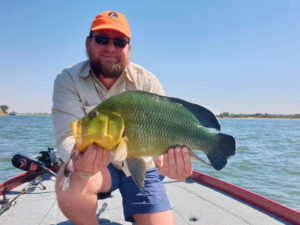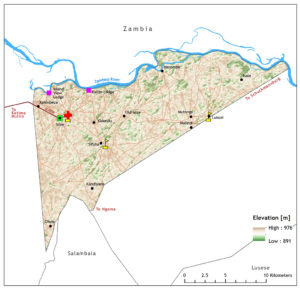KATIMA | ZAMBEZI
INTRODUCTION
Katima Mulilo is situated in the once world-renowned Caprivi Strip and is now the capital and largest city of the Zambezi Region. The Zambezi Region, formerly known as the Caprivi Region, is located in the extreme north-east of the country. It takes its name from the Zambezi River that runs along its border. Once known for its elephants, Katima Mulilo now thrives as a border town on the banks of the Zambezi River in lush riverine vegetation with tropical birds and small wildlife. The Zambian border (Shesheke) is 4km away and the Botswana border (Ngoma) is less the 100km away, with Rundu being the nearest Namibian town, about 500 km away.
The Zambezi River is the fourth longest river in Africa, the longest east-flowing river in Africa and the largest flowing into the Indian Ocean from Africa. The 2,574km long river arises in Zambia and flows through eastern Angola, along the north-eastern border of Namibia and the northern border of Botswana, then along the border between Zambia and Zimbabwe to Mozambique, where it crosses the country to empty into the Indian Ocean.
The Zambezi’s most noted feature is Victoria Falls. Other notable falls include the Chavuma Falls at the border between Zambia and Angola, and Ngonye Falls, near Sioma in Western Zambia.
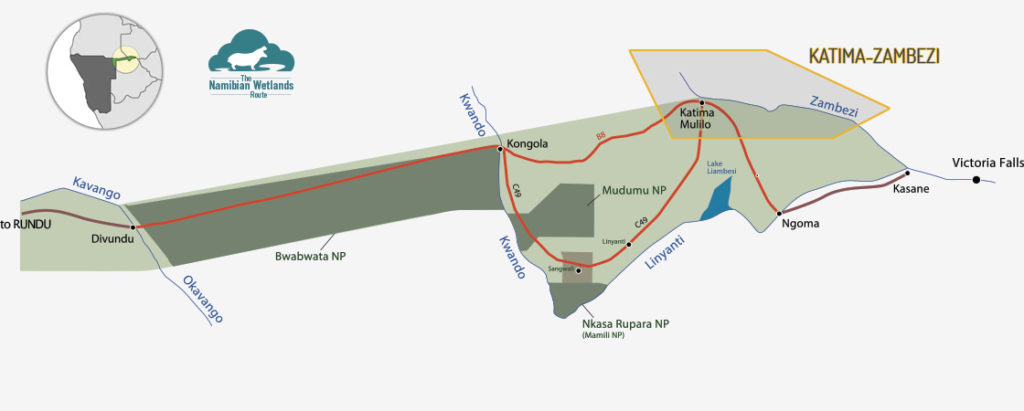
Katima Mulilo
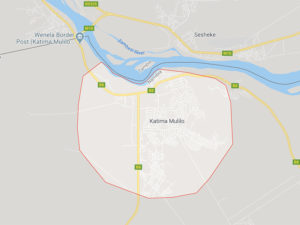 Katima Mulilo is an ideal stop over for visitors coming from or going to either Zambia or Botswana. The town has a variety of shops which includes banks, fuel stations, garages, restaurants, hardware shops, supermarkets, clothing stores, furniture shops and liquor wholesalers. For medical purposes the town has on offer doctors’ clinics, dentists, pharmacies and Katima Mulilo Hospital, a large government facility for minor medical emergencies. Katima Mulilo also has a number of grocery stores, such as Pick N Pay, Spar, Shoprite and Shakar Supermarket. All the banks in Katima Mulilo have ATMs for cash withdrawals. When dining in Katima Mulilo visitors will not be spoilt for choice as there are only a few restaurants on offer. For breakfast or lunch there is Caprivi Adventures Café and the coffee shop a Pick N Pay and for dinner there is Passione Restaurant and K&N Restaurant. When visiting Katima Mulilo it is highly recommended that time is taken to view the sights within and surrounding the town. A must to visit in town is the open-air market (opposite Shoprite) where tourists can get to see where local products are sold and have a walk around the Katima Mulilo Curio Market. The Museums Association of Namibia (MAN), sponsored by the European Union, is building a new museum in Katima Mulilo. This project is still under development. The largest visitors’ attraction to Katima Mulilo is the Zambezi River and its floodplains, where a variety of activities are on offer.
Katima Mulilo is an ideal stop over for visitors coming from or going to either Zambia or Botswana. The town has a variety of shops which includes banks, fuel stations, garages, restaurants, hardware shops, supermarkets, clothing stores, furniture shops and liquor wholesalers. For medical purposes the town has on offer doctors’ clinics, dentists, pharmacies and Katima Mulilo Hospital, a large government facility for minor medical emergencies. Katima Mulilo also has a number of grocery stores, such as Pick N Pay, Spar, Shoprite and Shakar Supermarket. All the banks in Katima Mulilo have ATMs for cash withdrawals. When dining in Katima Mulilo visitors will not be spoilt for choice as there are only a few restaurants on offer. For breakfast or lunch there is Caprivi Adventures Café and the coffee shop a Pick N Pay and for dinner there is Passione Restaurant and K&N Restaurant. When visiting Katima Mulilo it is highly recommended that time is taken to view the sights within and surrounding the town. A must to visit in town is the open-air market (opposite Shoprite) where tourists can get to see where local products are sold and have a walk around the Katima Mulilo Curio Market. The Museums Association of Namibia (MAN), sponsored by the European Union, is building a new museum in Katima Mulilo. This project is still under development. The largest visitors’ attraction to Katima Mulilo is the Zambezi River and its floodplains, where a variety of activities are on offer.
Zambezi River
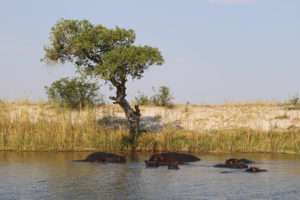 The Zambezi River is the fourth longest river in Africa and, from Katima Mulilo, has a variety of water activities on offer, these include river cruises, hippo and crocodile viewing, bird viewing and fresh water sport fishing. Boat cruises along the Zambezi are a splendid and extremely popular way to experience the river and to view a myriad of birds, huge pods of hippos and some of the largest crocodiles in Africa. Birding includes the largest Carmine Bee-Eater colony in Southern Africa, which attracts photographers from all around the world. Whilst cruising the river, visitors can also get to experience some of Africa’s most magnificent sunsets. For the more adventurous visitors can try their hand at sport fishing for the elusive tigerfish. Surrounding the river are the Zambezi floodplains, which is a sight not to be missed.
The Zambezi River is the fourth longest river in Africa and, from Katima Mulilo, has a variety of water activities on offer, these include river cruises, hippo and crocodile viewing, bird viewing and fresh water sport fishing. Boat cruises along the Zambezi are a splendid and extremely popular way to experience the river and to view a myriad of birds, huge pods of hippos and some of the largest crocodiles in Africa. Birding includes the largest Carmine Bee-Eater colony in Southern Africa, which attracts photographers from all around the world. Whilst cruising the river, visitors can also get to experience some of Africa’s most magnificent sunsets. For the more adventurous visitors can try their hand at sport fishing for the elusive tigerfish. Surrounding the river are the Zambezi floodplains, which is a sight not to be missed.
Birding in the Zambezi Region
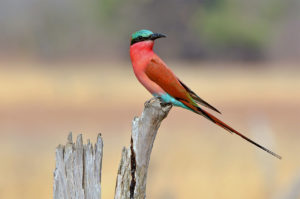 Bird viewing in the surrounds of Katima Mulilo is an absolute treat and undoubtedly a privilege not to be missed. With up to 450 species, birdwatchers and birding enthusiasts from around the world should include this small part of Namibia to their birding destinations. A sunset boat cruise is the ideal time to spot some of the Caprivi specials; such as the African Fish Eagle in action, African Hobby and Bat Hawk. Listen and look out for the beautiful Schalow’s Turaco that is often seen around a few lodges. Only 30km from Katima Mulilo is the largest Carmine Bee-Eater colony in Southern Africa, which attracts photographers from all around the world during the breeding season (towards the end of August until the beginning of October). The best time to see this magnificent spectacle is either early morning or late afternoon, which can be done from a vehicle during a floodplain drive or from a hired boat on the river.
Bird viewing in the surrounds of Katima Mulilo is an absolute treat and undoubtedly a privilege not to be missed. With up to 450 species, birdwatchers and birding enthusiasts from around the world should include this small part of Namibia to their birding destinations. A sunset boat cruise is the ideal time to spot some of the Caprivi specials; such as the African Fish Eagle in action, African Hobby and Bat Hawk. Listen and look out for the beautiful Schalow’s Turaco that is often seen around a few lodges. Only 30km from Katima Mulilo is the largest Carmine Bee-Eater colony in Southern Africa, which attracts photographers from all around the world during the breeding season (towards the end of August until the beginning of October). The best time to see this magnificent spectacle is either early morning or late afternoon, which can be done from a vehicle during a floodplain drive or from a hired boat on the river.
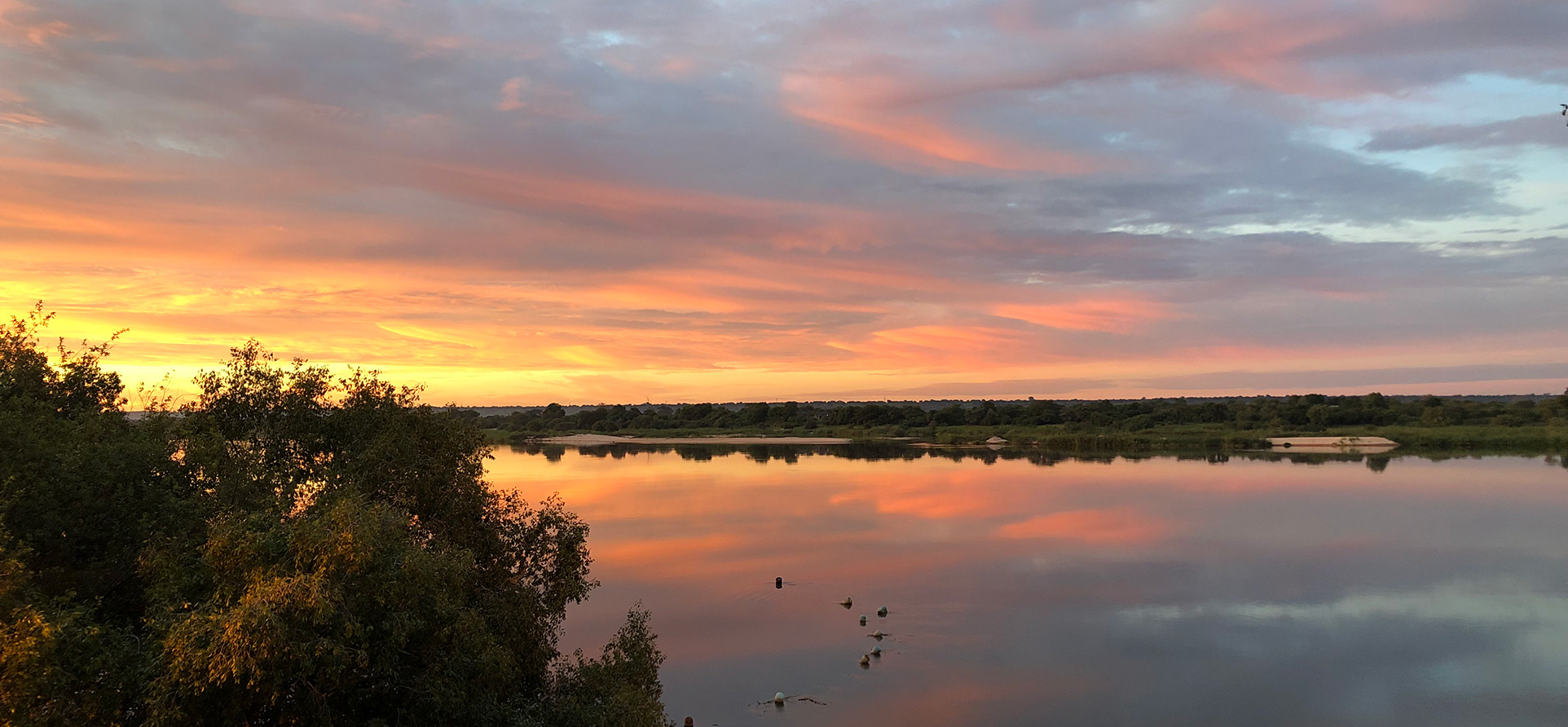
Zambezi Floodplains
One of the Zambezi Regions most hidden secrets is the stunning landscapes and bounties offered during the flood times, normally from March to June. During the floods, the once scorched earth starts to shimmer with fish teeming water, birds and an abundance of vegetation. Not only is this the fish breeding season but this is by far one of the most beautiful times to visit the Zambezi Region. The floodplains reach up to a distance of +/- 70km at its widest point in Namibia, covering huge areas of flat land. On receding the floods leave behind numerous freshwater lakes (Zambezi River backwaters) which are home to a myriad of birds and fish. The best way to visit the floodplains is either by motor boat, makoro or canoe, which can be organised through lodges situated on the bank of the Zambezi River.
Fishing in the Zambezi River
Fishing is a popular activity this can be done from either motorboats or makoros on the Zambezi River. Most tourist lodges situated along the river shores offer fishing excursion on a catch and release basis. Besides the elusive Tigerfish, the other most popular fish caught on the Zambezi are Barbel, Bream, Nembwe, Tilapia and Largemouth. Pike fish breed amongst the water lilies of the Zambezi Rivers’ backwaters, and is the only place in the area where these fish can be caught.
Sikunga Conservancy
Named after a Zambezi River channel which ‘brings things together’.
Quick Facts
Registered: July 2009
Area: 287 km2
Approximate population: 2,470
Geographical features:
Mainly floodplain grassland along the Zambezi River with broad-leafed woodland on areas of high ground away from the river. Average annual rainfall over 600 mm.
